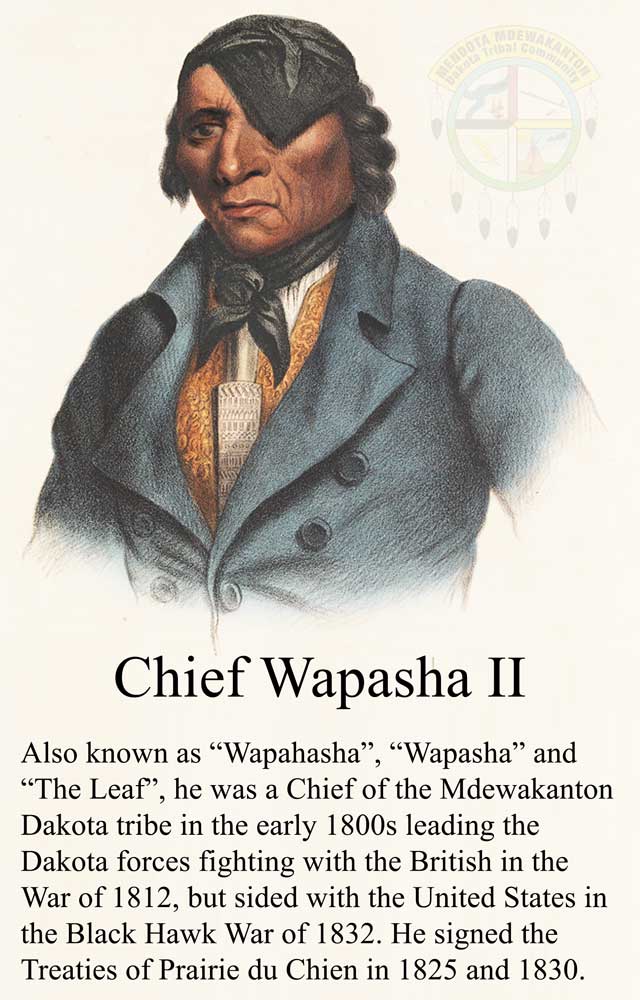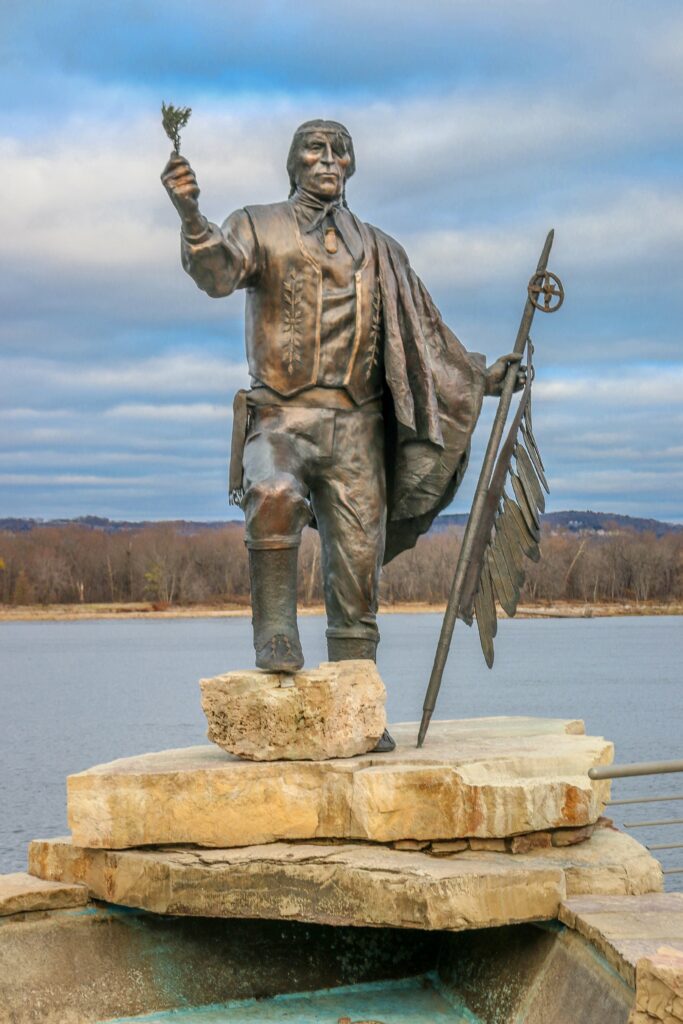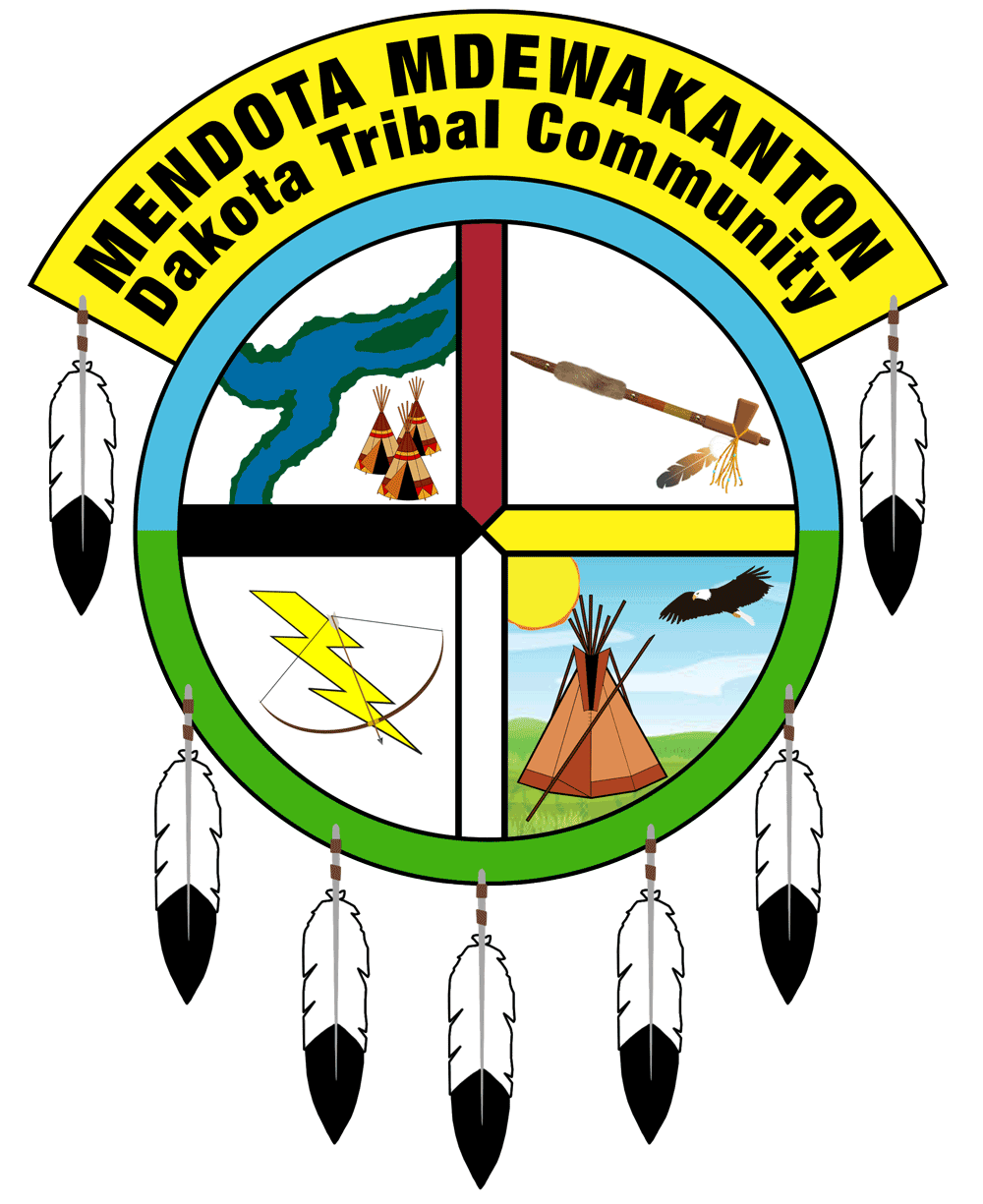MORTON, Minn. – Gripping a cane tightly, Ernest Wabasha slowly reached to touch a pair of heavy iron shackles hanging from his mantel – the same shackles his great-grandfather, the legendary Chief Wabasha, wore during a forced march across the southwestern Minnesota plains a century ago.

A portrait of Chief Wabasha hung nearby, surrounded by the strong faces of the Wabasha line before and after. The most recent are photos of Ernest and his son, Wabasha No. 6 and No. 7.
Ernest Wabasha’s eyes are watery and his 73-year-old body is frail, but the proud lift of his chin and the straight line of his mouth echo the framed pictures of his Mdewakanton Dakota ancestors.
Wabasha’s band endured a bloody war and was stripped of its south-central territory in the last century, but in time they made their way back. Asked about the strength of the Dakota – why they were driven to return – Wabasha became quiet and started straight ahead.
“It all comes back to leadership,” Wabasha said.
The Wabashas, the Goodthunders and the Bluestones are among the old names in new generations in the Lower Sioux Indian Community. Today’s Mdewakanton Dakota say they are renewing a commitment toward unearthing their past from these river bluffs and surrounding prairies.
“We are coming together as a group again, as a Mdewakanton tribe,” said Jody Goodthunder, a council member and former chairman. “We are reverting back to our culture. A lot of our members are moving back to the old ways.”
The band’s reservation once felt nearly hidden among the cornfields just outside Redwood Falls. Men and boys would work for local farmers, often paid with a bag of flour or some meat. Too poor to afford cars, families would walk down the hill to town, to school and to church.
Today, the roads bustle with traffic to the band’s Jackpot Junction casino and new Dacotah Ridge Golf Club, a popular trend among reservations that are expanding into golf to create resort-like destination points.
Crews busily clean the reservation’s water tower, and dump trucks roll by to the building site of a community center that will soon replace a split-level house as the center of tribal functions.
About half of the almost 800 registered Lower Sioux members live on the 1,700-acre reservation – mainly in modest homes clustered in small circles off gravel roads.
They have to live within 10 miles of the reservation to receive their share of the Jackpot Junction revenue, an amount that isn’t disclosed to outsiders. Trust funds are held for the Lower Sioux children, who gain access to part of it at age 18. The remaining money is received at 21.
In the past decade, median household income on the Lower Sioux reservation jumped 300 percent to $69,792 in the year 2000 from $16,223 in 1989, according to census figures adjusted for inflation. It was the second-highest median income on the 11 reservations in Minnesota, trailing only Prairie Island ($76,186).
The new money is luring band members home, like Kaye Hester, who returned this summer after leaving three decades ago as an impatient 21-year-old.

“People are gathering back together, learning the ways of each other. I never thought I’d come back. There was no hope here,” Hester said.
Despite the new homes and roads, there are plenty of historical markers to remind members of a past that has been difficult. They show where the Dakota, starving and ignored by local white leaders, attacked fur traders and then government posts in 1862, after years of uneasiness with settlers and treaty promises broken by the federal government.
Over 500 people on both sides were killed in a six-week battle. It led to the largest mass execution in U.S. history when thousands of people gathered in Mankato the day after Christmas to watch 38 Dakota men hang under the orders of President Abraham Lincoln.
On the western edge of the Lower Sioux reservation, another post marks where hundreds of Dakota were court-martialed. Hundreds more were marched to a prison camp at Fort Snelling. They were eventually shipped by boat and railroad to a reservation in South Dakota, later moving south to a reservation in Nebraska. A bounty was put on their head in case they tried to return to Minnesota.
But the Mdewakanton Dakota did come home, many walking back to Minnesota from Nebraska and South Dakota.
They gathered in small clusters, and 12 years after the war a Dakota leader known as Good Thunder came from South Dakota and purchased 80 acres at the Lower Sioux community. Within a few years a small colony formed, including some Dakota who had been protected by white settlers. By 1936, the census reported 20 Mdewakanton families, 18 families from Flandreau, S.D., and one Sisseton, S.D., family.
Some Lower Sioux say an undercurrent of division remains between Indians and non-Indians in the area, with generations carrying a grudge without really knowing what happened, said Goodthunder, a descendant of the 19th-century leader.
“We had to live the hard way, wondering why people felt the way they did about us,” he said. “Our parents tried to protect us by not telling our history. It probably would have helped us if we would have understood why they had prejudice against us.”
Goodthunder said he didn’t learn why the events of 1862 happened until he was older. He said he recalls slanted depictions from public school, including a history book with a drawing of an Indian holding a white baby by the hair.
“They would call us murderer, savage,” he said.
The Lower Sioux, traditionally called “Cans’a yapi” or “where they marked the trees red,” were the heart of the government’s program to “civilize” the Dakota. The government tried to turn the Indians into Christian farmers after treaties in 1851 diminished the tribe’s land to 4 percent of what they held across southern and western Minnesota, according to the Minnesota Historical Society.
The band is still recovering tribal traditions that were buried with the assimilation efforts or left behind when the Dakota were forced out after 1862.
Among the people leading the efforts are Crystal Mountain and her husband, Virgil, who run the Buffalo Horse Camp on the outskirts of the reservation, where children create gardens alongside elders using heirloom seeds and learning traditional methods.
They’ve grown tobacco, teaching about its sacredness, and returned important medicinal herbs to the area like sage and sweetgrass.
“If you don’t use them, they will go away,” Crystal Mountain said.
“It’s about reinstalling their sense of identity,” she said. “A lot was lost culturally and the effects are still here. It’s a process to really look and find the people who possess that knowledge.”
Among the Lower Sioux elders are 86-year-old Maude Williams and her younger sister, 77-year-old Betty Lee. Both widowed, the sisters live together in a small house under the watertower in the middle of the reservation.
From their front window you can see a stone church; nearby, the Lower Sioux recently gave a traditional burial to Dakota remains they recovered from museums and universities that had held them in archaeological and Indian collections.
The sisters laugh as they shuck corn, telling stories of a rooster that chased them in their childhood trips to the family outhouse. There were few families at that time living on the reservation, and no electricity or running water.
Their father, Samuel Bluestone, was the first chairman of the Lower Sioux, serving in the early 1930s. He worked for a farmer who paid him with a 5-pound bag of flour or sugar.
“We didn’t know we were poor,” Williams said. “We didn’t see the other side.”
As girls, they were sent to Indian boarding schools and both later moved to the Twin Cities. Lee was the first to return to the reservation, in the early 1970s, to care for her mother and brother. Williams followed in 1985.
The Lower Sioux was the same as when they left – no jobs and no money. Lee, who became a longtime tribal council member, was part of the reservation’s transformation through gambling revenue.
Lee said the Lower Sioux didn’t become rich. But she could finally afford to buy foods that her brother, who is autistic, never could get, like a glass of milk or a bowl of ice cream.
“At least we got caught up to what a normal person would have in life, at least we have a comfortable life,” she said. “Our children get a little more food.”
More band members are getting an education and taking advantage of scholarships funded by the Lower Sioux. Goodthunder ticks off the places where some band members are continuing school: Arizona, California, Minneapolis.
On the reservation, the band’s focus is beyond the casino to how they can make the Lower Sioux a family destination with possible attractions like a water park, Goodthunder said.
Just down the hill in the nearby town of Morton, furniture store owner Kate Colwell said it’s fantastic to see her former classmates now managing a multimillion dollar business.
The children who came from Lower Sioux were always quiet, but she said they were talented artists and respected. One of the girls was the class homecoming queen, she said.
Colwell acknowledged that the reservation “probably had a whole different view than I did.” But she praised the casino, crediting it for bringing some visitors to her Amish store.
“They came from such poverty,” she said, “It’s wonderful to see the reservation now.”
